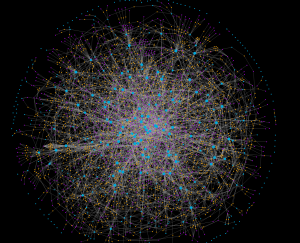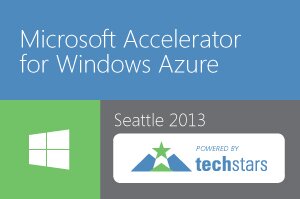Posted under Data on August 9th, 2013 by Mary Haskett
We are working with large amounts of Facebook data. BeehiveID is, at its heart, an algorithm and an algorithm is always growing and changing as we get new data and draw conclusions based on existing data.
Below is a representation of Alex’s Facebook profile. You can see he has a rich, deep network of connections to some people. But if you look on the periphery, you see a ring of isolated blue dots. These are the people that have no connection to him other than an initial friend request. You can’t really see this in Facebook at all, but once you visualize it in a graph, it is immediately apparent.

[Click to zoom in for awesome detail]
In our experience, most profiles are like this – about 20% to 30% of the connections are totally isolated. Of course, this begs the question – why do we have these people in our networks at all, if we never interact with them?
Posted under Start up on July 19th, 2013 by Mary Haskett
 One of the odd things about being in the Microsoft Accelerator was the camera crew that randomly showed up now and then. This is a picture of me getting my microphone adjusted for demo day. It’s slightly disconcerting to have another person adjusting your clothing; it’s just not something that happens very often.
One of the odd things about being in the Microsoft Accelerator was the camera crew that randomly showed up now and then. This is a picture of me getting my microphone adjusted for demo day. It’s slightly disconcerting to have another person adjusting your clothing; it’s just not something that happens very often.
It’s also slightly disconcerting to have a film crew working around you. I’m sure being the only female co-founder in our cohort made me more of a magnet for the camera crew than others, but they followed everyone. Walking downstairs to The Easy for a presentation, I turned and realized someone had been walking behind me and filming without me realizing. You notice a video camera out of your peripheral vision, but you aren’t supposed to look at the camera. But once you notice it, it’s hard not to look. It’s just odd.
We did video interviews over the course of the three month program and it actually ended up being a great preparation – being a founder is all about telling your story to everyone who will listen and video is a great way to reach more people.
Posted under Start up on July 7th, 2013 by Mary Haskett
This is another blog post about our experiences in the Microsoft Accelerator powered by TechStars program so if you are more interested in biometrics or privacy you can just skip this one and go to the next entry. =)
 To me, the main reason to join an accelerator program is to get access to the mentors and other resources in the network. Over the course of the three month program, we had dozens of people who were experts in their various areas come to us and talk about various topics. Plus mentors came in weekly to work specifically with us on our business. I think it would have easily taken me a year to set up and have the meetings I had during the program – assuming I could have gotten them to even answer my call.
To me, the main reason to join an accelerator program is to get access to the mentors and other resources in the network. Over the course of the three month program, we had dozens of people who were experts in their various areas come to us and talk about various topics. Plus mentors came in weekly to work specifically with us on our business. I think it would have easily taken me a year to set up and have the meetings I had during the program – assuming I could have gotten them to even answer my call.
We had over 120 meetings during the three month program with potential investors, technical mentors, pricing mentors, marketing mentors, sales mentors, operations mentors, potential customers and other founders. There is a downside – it’s hard to keep track of that many people. And with that many people listening to your concept and giving you feedback, you are going to get a lot of confusing and conflicting advice. It’s called “mentor whiplash” and it’s just what it sounds like.
Also, mentors typically only met with a few companies, so they remembered us (especially me with my long white hair). However, we met with hundreds of mentors and couldn’t remember them all. There were several embarrassing moments when someone would come up to us on the street as if they knew us, and we just had to pretend we remembered them until we figured out who they were.
There were days when I went home at the end of the day and my brain was so full that I could not remember who I had met and I had to review my notes. It takes time to sort through conflicting advice, research alternatives, get second opinions or maybe third opinions (what if that guy is super famous but also just wrong?) and time is not something you have a lot of in an accelerator. You spend a lot of time walking around in a fog.
But how on earth is a start-up going to get that kind of attention without a program like this?
Posted under Start up on June 28th, 2013 by Mary Haskett
We got to work very closely with Microsoft in the Microsoft Accelerator program. I think this is one of the biggest differences between this program and the regular TechStars program. We were issued Microsoft badges so we could work onsite and meet with Microsoft people at any time. There were dozens of Microsoft people in all the various departments that were relevant who were amazingly generous with their time.
We met with their pricing team who reviewed our pricing and provided feedback. We had weekly meetings with their technical people working on Azure who reviewed our architecture, looked at code, helped us identify problems and optimize everything.
The facilities are amazing – I took a photograph of a water feature in the landscaping near one of the cafeterias and everyone thought it was a photo from a resort. Oh, did I mention a large amount of free credit on Azure to get us started?
Posted under Start up on June 7th, 2013 by Mary Haskett
 BeehiveID has recently graduated from the Microsoft Accelerator for Windows Azure in Seattle. It was run by TechStars and structured like any TechStars program, but we got to work very closely with Microsoft. I haven’t talked much about our experience there but I’m going to dedicate a few blog posts to it because we have a lot of people ask us about accelerator programs in general and TechStars in specific. Plus it was a wonderful experience, kind of like a cross between graduate school and summer camp. They did a series of videos and I’ll be linking to those as well.
BeehiveID has recently graduated from the Microsoft Accelerator for Windows Azure in Seattle. It was run by TechStars and structured like any TechStars program, but we got to work very closely with Microsoft. I haven’t talked much about our experience there but I’m going to dedicate a few blog posts to it because we have a lot of people ask us about accelerator programs in general and TechStars in specific. Plus it was a wonderful experience, kind of like a cross between graduate school and summer camp. They did a series of videos and I’ll be linking to those as well.
We actually started the program with the the tag line “Twilio for biometric matching”. Our first concept was to create an API so that other developers could incorporate biometric matching – fingerprint, iris or face – into their own applications with one or two lines of code. Biometrics is a field that is growing rapidly and there are many, many applications of the technology but it’s a bit on the arcane, poorly documented side. We thought (and still do) that it would be cool to develop a tool that would make it easier.
The thing about TechStars, and I suspect every accelerator program out there, is that despite the “Tech” in the title, the focus is on the market. It doesn’t matter how cool your technology is if nobody will buy it. More start-ups fail because they build something wonderful that nobody wanted than vice versa. It became clear early on that selling to developers was going to be difficult. So almost the first thing we did was toss out the business concept that got us accepted into the program and start over.
Posted under Start up on May 10th, 2013 by Mary Haskett
This morning I flipped through the channels trying to see what the options were for cable in Seattle. I stopped for a few minutes on a TV show about Hoarders and it just chilled me to the bone.

No, I don’t feel crowded. This is a perfectly reasonable way to live.
It wasn’t the living conditions that scared me, it was the amazing ability of the person on the show to rationalize how they were living and how unable they were to part with what was obviously trash. I don’t mean items that might have use to anyone, but cheap plastic toys that came with a fast food meal years ago that is of no use to anyone.
I know that hoarding is a psychological disorder but I also know that it’s human nature to see what you want to see and hear what you expect to hear.
So I’m in the Microsoft Accelerator for Windows Azure powered by TechStars and we are spending an enormous amount of time validating our business idea by talking to potential customers and finding out if they are willing to pay for what we want to build. Sounds really straightforward and it should be. It’s just not.

Let’s just keep collecting data until someone offers to buy us.
I talk to someone who loves what we are doing and wants to be a beta tester. That’s a really good sign, right? Maybe, or maybe they just like mucking about with new technology but don’t have a financially viable use. I talk to someone who says our technology really wouldn’t solve the problems they are facing. Well, that’s OK because our technology certainly isn’t for everyone, right? Maybe, or maybe I’m just unwilling to see the obvious signs that there isn’t sufficient interest.
I need to get out of the building and talk to 100 potential customers. But I also need to avoid analysis paralysis and make a decision quickly and decisively move forward. We need one customer that is cool and interesting so we can get the word out about our platform and we should also get out and evangelize the developer community. We need to make careful, thoughtful decisions based on collected data but we need to do it quickly. You shouldn’t build anything until you know there is a big enough market of people willing to pay for it but you should also just focus on building amazing things and the money will follow.

Yep. Pretty much how it works for me.
The path to success been a tangled, muddy mess for all my past triumphs. In the middle of it all, it’s complicated and even the obvious, clear indicators were only so clear in hindsight. I guess all you can do is get used to and make peace with the tangled mess and just keep swimming.

Just keep swimming.
Posted under Biometrics, Privacy on March 7th, 2013 by Mary Haskett
As a co-founder of a company focused on bringing biometric matching to the masses, I sometimes encounter people who assume that I’m not interested in privacy. Admittedly the Department of Defense background doesn’t help. It’s a balance though – privacy is an issue I’m really interested in and we think about it often. I see great reasons for anonymity on the internet and in other places in the world but I also see it abused. Political speech is one example but by no means the only one. There are great use cases that support strong identity on the internet and in the world as well. When I’m reading a product review, I would like to know if the person writing the review is a real person. They are both right.
Alex and I talk about this often. Here’s an Ignite presentation he did a while ago on how to defeat biometric technology:

 One of the odd things about being in the Microsoft Accelerator was the camera crew that randomly showed up now and then. This is a picture of me getting my microphone adjusted for demo day. It’s slightly disconcerting to have another person adjusting your clothing; it’s just not something that happens very often.
One of the odd things about being in the Microsoft Accelerator was the camera crew that randomly showed up now and then. This is a picture of me getting my microphone adjusted for demo day. It’s slightly disconcerting to have another person adjusting your clothing; it’s just not something that happens very often.




